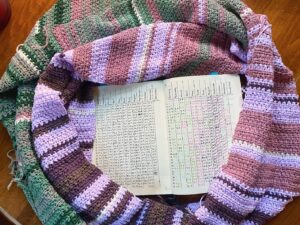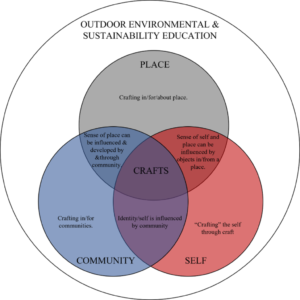Developing Connections through Craft and Reflection
About the author

Jessica Chamberlin graduated from the Outdoor Environmental and Sustainability Education MSc Programme in 2023. Her research focuses on the role of crafting in outdoor education, and she plans to continue this research into a PhD programme soon. She now works at Embry-Riddle Aeronautical University as an Educational Support Specialist and loves working with the students on campus and is excited to learn more about some of the advanced physics and math lessons they are studying. In her spare time, she enjoys crafting, reading books with obscure subjects, walking outdoors, and dancing in public places to embarrass her family. Contact Jessica for more information at jessica.n.chamberlin7@gmail.com
Fibers of Reflection
I forgot to pack a hat to go canoeing down the river Spey on our first residential. So, in the spirit of Outdoor Environmental and Sustainability Education (OESE), I learned how to make one. My experiences during this two-week residential influenced the way I lived through and learned from the rest of the program. The making of this hat sent me on a path of exploring how crafting can play a role in OESE.
My research used these experiences with crafting as my data set to explore how crafting can allow learners to develop connections to place, community, and self. I utilized an interpretive autoethnography methodology where I told stories of my experiences with crafting during this transformational time.
Connection to Place, Community, and Self
I began exploring my relationship with place by reflecting upon the feeling of placelessness. Some individuals struggle with a “disconnection to place” when they move to a new location (Smith and Segbers, 2018, p. 83). International students are one such population that may struggle with a feeling of placelessness. In my search to develop a “sense of place,” I crocheted a temperature scarf with every row representing the average daily temperature for every day of 2022. Though this project was fairly simple to complete, the results of the craft were greatly influential to my connection with the city of Edinburgh and Scotland as a whole. As I crocheted the 32 stitches into every row, I embedded my memories of each day into this scarf. This scarf told the story of the city while also telling my story as the crafter.

Image 1: Edinburgh 2022 Temperature Scarf with colors representing the average daily temperature in 3°C increments with dark green as the coldest days and dark purple representing the warmest days.
Learning a craft can connect people. Through my writing I explored how I developed a relationship with my peers in the OESE program who also loved to craft, to my father who I created a blanket for during a particularly emotionally traumatic experience, to my unborn niece that I dedicated many hours to creating a blanket for, and to my grandmother who had passed many years prior, but who loved to crochet as well. Developing this connection with community in OESE allows for greater shared knowledge, skills, and values. Crafting in and for a community can assist in developing and strengthening the bond between maker and community.
My experience in Scotland influenced my sense of self and has changed the way I see myself as an educator, crafter, and person. Crafting allows us to not only craft our lives, but also provides us with valuable analogies to understand how we live our lives. Korn (2013) argues that one can use craft/making as a way to “design… a vision of a good life” (p. 59). Crafting is a meditative art. The crafter can sit, stand, or walk while crafting and think and reflect on life. My experiences with crafting during the OESE program have influenced my sense of self and my identity. Through crafting I was able to meditate and reflect using repetitive motions to slow down and reflect upon my life.
Outdoor Environmental and Sustainability Education and Craft
Crafting is important to educational pedagogy (Garber, 2002; Karppinen, 2008; Pöllänen, 2009) because the crafting process requires problem solving activities, knowledge retrieval, and reflection (Lindfors, 1999). Therefore, by introducing craft into OESE curriculum educators and learners may be able to reflect upon and connect their experiences in the outdoors to greater ideas such as place, community, and self. Figure 1 displays how the three foci of place, community, and self interact through craft within the realm of OESE.

Figure 1: Connections of place, community, and self to craft in outdoor environmental and sustainability education.
This dissertation was an exploration of my experiences with crafting from August 2021 to November 2022 in Scotland. By reflecting upon these experiences, I was able to develop connections to place, community, and self during my time in the OESE program at the University of Edinburgh. My experience in Scotland as well as the process of writing this dissertation was a transformational experience.
These transformational experiences have led me to value my story, ideas, and products of my craft and have made me a better crafter, learner, and educator.
References
Garber, E. (2002). Craft education in Finland: Definition, rationales, and the future. International Journal of Art & Design Education, 21(2), p. 132-145.
Karppirens, S. (2008). Craft-art as a basis for human activity. International Journal of Art & Design Education, 27(1), p. 83-90.
Korn, P. (2013). Why we make things and why it matters: The education of a craftsman. Vintage.
Lindfors, L. (1999). Sloyd education in the cultural struggle: An outline of a sloyd educationaltheory. Reports from the Faculty of education No. 4, Åbo Akademi University.
Pöllänen, S. (2009). Contextualizing craft: Pedagogical models for craft education. International Journal of Art & Design, 28(3), p. 249-260.
Smith, H. and Segbers, T. (2018). The impact of transculturality on student experience of highereducation. Journal of Experiential Education. 41(1), p.75-89.




Comments are closed
Comments to this thread have been closed by the post author or by an administrator.